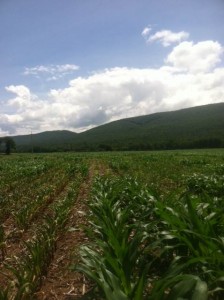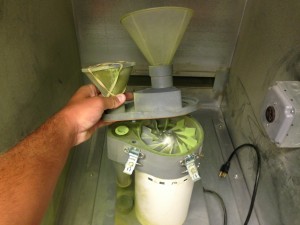Last week was busy down here and we lost a Friday because of Independence Day, so I have two weeks to catch up on! I have spent a lot of time outside in the vineyards these past two weeks and that has been a lot of fun. Most of the work has involved Tim’s rootworm project, both his experimental nematode pots here at the office  (photo to the right) and a spray trial out in the vineyard. Last week we counted rootworm (photo to the lower left) in different blocks that would be treated with different insecticides and on Wednesday of this week we examined the plants to see if the sprays had been effective. When scouting for rootworm it is important to recognize the damage they cause on the plants and leaves. The photo on the lower right shows the chain-like feeding pattern characteristic of rootworm adults.
(photo to the right) and a spray trial out in the vineyard. Last week we counted rootworm (photo to the lower left) in different blocks that would be treated with different insecticides and on Wednesday of this week we examined the plants to see if the sprays had been effective. When scouting for rootworm it is important to recognize the damage they cause on the plants and leaves. The photo on the lower right shows the chain-like feeding pattern characteristic of rootworm adults.
There are weekly meetings called Coffee Pot meetings that growers can attend to discuss what is going on in the vineyards, and I was able to attend them the past two Wednesday’s. I don’t have a lot of knowledge or experience about what it takes to actually manage a vineyard and it was really interesting to listen to what the grower s had to say. Pesticides and nutrient requirements were the major topics of discussion. I have learned about both of these in my classes at Cornell, but it really solidifies the information when you are talking about it with actual growers; it’s beneficial to listen to the important factors to consider, such as what the major nutrient issues are and which pesticides are recommended for which pest and labeled for use in New York.
s had to say. Pesticides and nutrient requirements were the major topics of discussion. I have learned about both of these in my classes at Cornell, but it really solidifies the information when you are talking about it with actual growers; it’s beneficial to listen to the important factors to consider, such as what the major nutrient issues are and which pesticides are recommended for which pest and labeled for use in New York.
I once again took my weekly leaf samples and counted both TSSM and predatory mites. I have seen an increase in TSSM, but I am not seeing very many predatory mites. This isn’t what I expected, as I released 40,000 predatory mites into the hopyard, so it will be interesting to see the kind of numbers I get in the coming weeks.
On Friday we were outside all day planting another hopyard! There are five more production rows of different varieties, Centennial, Perle, Newport, Sterling, and Fuggle. This will allow research to be done on more varieties, as well as in two separate plots, which will eventually allow for a project to be done on the release times of predatory mites.
Saturday I went to another Hops Field Day, similar to the one CLEREL held in June, but this time in Geneva. There were several speakers discussing topics relevant to interested growers. I was able to talk a little bit about my project and the data I have collected, as well as general scouting a hop grower would do in his yard for TSSM.
Rootworm photos by Tim Weigle





















